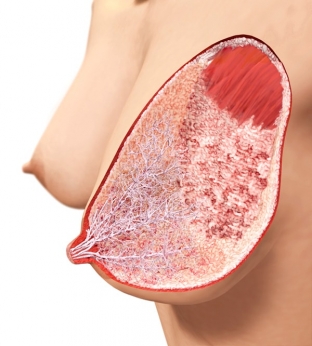Women's Breasts – a source of pride and admiration for men. Women give a huge amount of time, money and effort to caring for their own breasts, since it is this part of the female body that mainly distinguishes the fair sex.
But besides the aesthetic function, the breast is also an important reproductive organ that produces breast milk – the very first and very important type of food for a baby. During pregnancy, a woman's breasts prepare for subsequent births and the onset of lactation, and important breast changes after childbirth occur in the first few days of a baby's life.
What changes occur with the female breast after childbirth
Breast – This is an organ of the female body, which, under the influence of the endocrine system, is able to secrete breast milk. During pregnancy, a woman's breasts adapt to the new conditions of the body and prepare for the start of the lactation period, that is, breastfeeding.
The physiological structure of the female breast is created by nature in such a way that the baby can get the food he needs as comfortably and easily as possible. The female breast after childbirth begins to produce two types of dairy products: in the first days after childbirth, it is colostrum, and then – breast milk. Their composition and quantity normally satisfy the child's needs for nutrients, and also significantly affect the state of the infant's immune system.
Breast after childbirth:
- what processes occur in the female breast after childbirth;
- colostrum – the first product that the breast produces after childbirth;
- why is it so important for a newborn to get breast milk for food.
What processes occur in the female breast after childbirth
A few days before the birth, the final restructuring of the mammary gland is completed. In the female breast after childbirth, the following processes occur:
- mammogenesis – direct development of the mammary gland itself;
- lactogenesis – breast milk production;
- galactopoiesis – stable maintenance of breast milk secretion;
- galactokinesis – processes of removing milk from the ducts of the mammary gland.
 During the first 48 hours of a child's life, the structure of the mammary gland changes significantly: glandular cells become tall, they contain a large amount of rough endoplasmic reticulum and microvilli on their apical surface. The alveoli at this time are filled with milk, as a result of which the epithelial cells are deformed. In the postpartum period, the beds in the mammary gland are significantly enhanced, which has a positive effect on the rate of breast milk production.
During the first 48 hours of a child's life, the structure of the mammary gland changes significantly: glandular cells become tall, they contain a large amount of rough endoplasmic reticulum and microvilli on their apical surface. The alveoli at this time are filled with milk, as a result of which the epithelial cells are deformed. In the postpartum period, the beds in the mammary gland are significantly enhanced, which has a positive effect on the rate of breast milk production.
Colostrum – the first product that the breast produces after childbirth
Colostrum – this is the secret of the mammary gland, which is produced by the female breast after childbirth, & nbsp; in the first 2-3 days. Colostrum is a very dense milk product in its structure, which includes colostrum bodies, leukocytes and milk globules.
Unlike breast milk, colostrum contains a much higher content of proteins, fats and minerals, and significantly less carbohydrates, due to which colostrum has a fairly high energy value. Leukocytes, among which there are many lymphocytes and segmented, as well as immunoglobulins, which are also part of colostrum, are active "defenders" of organism newborn.
The yellowish color of colostrum is due to the presence of carotenoids in its composition.
Why is it so important for a newborn to get breast milk for food
Breast milk – this is the most suitable type of food for a newborn, which is produced by the female breast after childbirth. Human milk protects the baby's body from the effects of many harmful external factors, since its cellular composition & nbsp; represented by leukocytes.
The proteins contained in human milk are ideal, as their energy value is 100%, while the highest content of breast milk proteins is represented by albumins. Breastfeeding is extremely important for the adequate functioning of the body of the newborn. The lactation period lasts for each woman in labor for a different amount of time.
In case of insufficient production of breast milk, the process can be improved by increasing the frequency of feeding, since adequate milk production has a positive effect on its production. But even if a woman does not lactate after childbirth, you should not despair, since modern formulas for artificial feeding are maximally adapted and resemble breast milk in their composition.







Add a comment